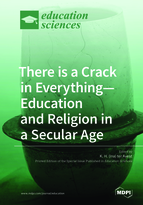There is a Crack in Everything—Education and Religion in a Secular Age
A special issue of Education Sciences (ISSN 2227-7102).
Deadline for manuscript submissions: closed (30 June 2018) | Viewed by 74293
Special Issue Editor
Interests: identity development; (religious) education; Islam in/and pedagogy
Special Issues, Collections and Topics in MDPI journals
Special Issue Information
Dear Colleagues,
The seemingly paradoxical situation of an expected decline of religion in the public domain and the increase of religiousness and spirituality in people’s lives, urged Peter Berger to revisit his prophecy regarding secularization. In1967, in his publication ‘The Sacred Canopy’, Peter Berger initiated the exploration of religion in today’s world. In those days the starting point for his elaboration was the observation that modern man is facing an increasing irrelevance of religion. According to Berger, modernity would necessarily bring about a decline of religion. However, in later years and due to encounters with religiosity in other contexts, among others in the third world, and resulting from meetings with Evangelical Protestantism in the US, Berger changed his line of thought. It turned out, Berger admitted, that modernity did not unavoidably result in a decline of religion. In the decades to follow the publication of ‘The Sacred Canopy’ secularization instead of a decline of religion, produced a reflective process on people’s religious positionality, resulting in pluralization. Nowadays, Berger says, people live in a context of competing beliefs, values and lifestyles (Berger et al., 2017). Two kinds of pluralism are identified by Berger (ibid., p. 17 ff.): On the one hand, pluralization needs to be understood as the situation in which different religious traditions coexist in the same public domain. On the other hand, the coexistence of religions with the dominant secular discourse. Today’s society, according to Berger, cannot exist without the pluralism dialogue(s) (ibid., p. 18). Following from this, and following Berger, is a need to teach and learn to speak and understand each other’s language, enabling people to enter a dialogue about a moral pluralism that might evolve from religious diversity (ibid., p. 25) and the need for (some) social cohesion (see also Hermans & Gieser, 2010).
An important step forward in the secularization discourse was, and has been even since, Charles Taylor’s publication ‘A Secular Age’ in 2007. In that publication Taylor states that ‘secularization primarily refers to the beliefs of people … fewer people are influenced by religious beliefs’ (Taylor, 2007, p. 430). Modernity’s characteristic of secularity and the proximity of religious and secular alternatives, insert severe doubt concerning one’s own positionality regarding one’s own and other religions, including its ‘strong evaluations’— those values that are ‘incommensurably higher that others’ (ibid., p. 544). Encounters in a plural society can be disruptive moments (Ter Avest, 2014), putting the finger on the problem of the fragility of a person’s worldview identity, possibly resulting in an intergenerational change and adoption of a different position than the parents (Taylor, 2007, p. 833). Taylor points to different strategies people pursue to create an alternative for the ‘sacred canopy’, the ‘paradise los’. Pop festivals, football matches and sports activities seem to be a satisfactory substitute for what religion was in earlier days.
As scholars in the field of education we wish to contribute to the ongoing debate on secularization and pluralization, focusing on the meaning thereof for the education of today’s youngsters—being the constructors of tomorrow’s world. In this Special Issue we explore different aspects of Education and Religion in the 21st century. Of course we will meet the need for conceptual clearness of core concepts, such as secularization, pluralization, religion, worldview and education. The different ways of perceiving ‘a secular age’ in different national and cultural contexts will be explored. The variety of ways responding to modernity’s challenges in education will be studied, in relation to the change of religion’s position in the different national and cultural contexts. The relation between education and religion will be explored, and its intersectionality with the level of education, the socio-economic status, and gender. A hot item nowadays is the relation of education and religion to the radicalization of Islam, or—to put it differently—Islamization of radicalism; an exploration thereof can not be missed in this Special Issue. The way ‘religion’ is perceived by youngsters, and how this is materialized in their life world is a ‘must’ in this Special Issue. Last but not least: the role of the teacher and the classroom context in our view are of pivotal importance. This is not an exhaustive enumeration of possibilities for a contribution to this Special Issue on Education and Religion in a secular age. Please feel invited to send an abstract to [email protected]. The deadline for abstracts is December 15, 2017.
K. H. (Ina) ter Avest
Guest Editor
References
- Berger, P. (1967). The sacred canopy. New York: Double Day & Company Inc.
- Berger, P., S. Steets, W. Weisze (Eds.) (2017). Zwei Pluralisms. Positionen aus Socialwissenschaft und Theologie zu religiöser Vielfalt und Säkularität. Münster/New York: Waxmann.
- Hermans, H.J.M., T. Gieser (Eds.) (2012). Handbook of Dialogical Self Theory. Cambridge University Press.
- Taylor, C. (2007). A secular Age. Cambridge/Massachusetts/London: The Belknap Press of Harvard University Press.
- Ter Avest, I. (2014). Exclusive inclusion; special treatment for first generation students. Presentation at the Conference on Diversity and the Politics of Engaged Scholarship
- ‘A comparative study in Higher Education’. Bloemfontein, South Africa, January; Sivas and Ankara,Turkey, April.






